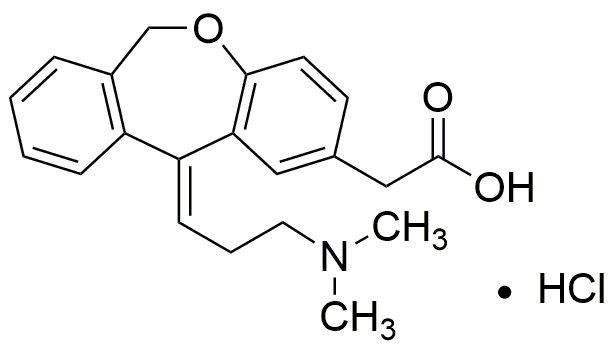Olopatadine hydrochloride is widely utilized in research focused on:
- Allergy Treatment: This compound is primarily used in the formulation of antihistamine medications, providing relief from allergic symptoms such as sneezing, runny nose, and itchy eyes. Its effectiveness makes it a preferred choice in the pharmaceutical industry.
- Ophthalmic Solutions: It is commonly found in eye drops designed to treat allergic conjunctivitis, offering targeted relief for eye-related allergies. This application is particularly beneficial for individuals who suffer from seasonal allergies.
- Dermatological Applications: Olopatadine is also explored in topical formulations for skin allergies, helping to reduce inflammation and itching. This makes it valuable in dermatology for managing allergic reactions.
- Research in Antihistamine Development: Researchers are investigating its mechanisms to develop new antihistamines with fewer side effects, enhancing patient compliance and satisfaction in allergy management.
- Combination Therapies: It is being studied for use in combination with other medications to improve efficacy in treating complex allergic conditions, providing a more holistic approach to patient care.
General Information
Properties
Safety and Regulations
Applications
Olopatadine hydrochloride is widely utilized in research focused on:
- Allergy Treatment: This compound is primarily used in the formulation of antihistamine medications, providing relief from allergic symptoms such as sneezing, runny nose, and itchy eyes. Its effectiveness makes it a preferred choice in the pharmaceutical industry.
- Ophthalmic Solutions: It is commonly found in eye drops designed to treat allergic conjunctivitis, offering targeted relief for eye-related allergies. This application is particularly beneficial for individuals who suffer from seasonal allergies.
- Dermatological Applications: Olopatadine is also explored in topical formulations for skin allergies, helping to reduce inflammation and itching. This makes it valuable in dermatology for managing allergic reactions.
- Research in Antihistamine Development: Researchers are investigating its mechanisms to develop new antihistamines with fewer side effects, enhancing patient compliance and satisfaction in allergy management.
- Combination Therapies: It is being studied for use in combination with other medications to improve efficacy in treating complex allergic conditions, providing a more holistic approach to patient care.
Documents
Safety Data Sheets (SDS)
The SDS provides comprehensive safety information on handling, storage, and disposal of the product.
Product Specification (PS)
The PS provides a comprehensive breakdown of the product’s properties, including chemical composition, physical state, purity, and storage requirements. It also details acceptable quality ranges and the product's intended applications.
Certificates of Analysis (COA)
Search for Certificates of Analysis (COA) by entering the products Lot Number. Lot and Batch Numbers can be found on a product’s label following the words ‘Lot’ or ‘Batch’.
*Catalog Number
*Lot Number
Certificates Of Origin (COO)
This COO confirms the country where the product was manufactured, and also details the materials and components used in it and whether it is derived from natural, synthetic, or other specific sources. This certificate may be required for customs, trade, and regulatory compliance.
*Catalog Number
*Lot Number
Safety Data Sheets (SDS)
The SDS provides comprehensive safety information on handling, storage, and disposal of the product.
DownloadProduct Specification (PS)
The PS provides a comprehensive breakdown of the product’s properties, including chemical composition, physical state, purity, and storage requirements. It also details acceptable quality ranges and the product's intended applications.
DownloadCertificates of Analysis (COA)
Search for Certificates of Analysis (COA) by entering the products Lot Number. Lot and Batch Numbers can be found on a product’s label following the words ‘Lot’ or ‘Batch’.
*Catalog Number
*Lot Number
Certificates Of Origin (COO)
This COO confirms the country where the product was manufactured, and also details the materials and components used in it and whether it is derived from natural, synthetic, or other specific sources. This certificate may be required for customs, trade, and regulatory compliance.


